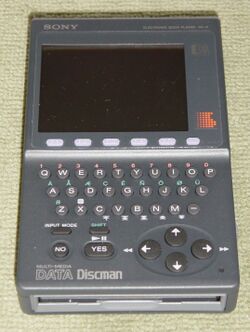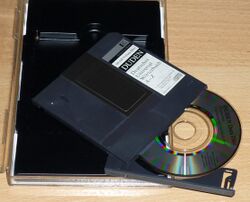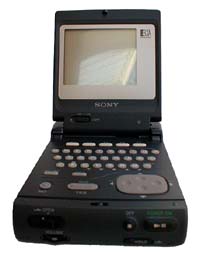Engineering:Data Discman
The Data Discman is an electronic book player introduced to the Western market in late 1991 or early 1992 by Sony Corporation.[1] It was marketed in the United States to college students and international travelers, but had little success outside Japan.[citation needed] The Discman product name had originally been applied to Sony's range of portable CD players such as the Sony Discman D-50, first released in 1984.[2]
The Data Discman was designed to allow quick access to electronic reference information on a pre-recorded disc. Searching terms were entered using a QWERTY-style keyboard and utilized the "Yes" and "No" keys.[citation needed]
A typical Data Discman model has a low resolution small grayscale LCD (256x200 early on, later models would have up to 320x240 and in colour), CD drive unit (either Mini CD or full size), and a low-power computer. Early versions of the device were incapable of playing audio CDs. Software was prerecorded and usually featured encyclopedias, foreign language dictionaries and novels.[citation needed] It was typically created using the Sony Electronic Book Authoring System (SEBAS).[3]
A DD-1EX Data Discman is in the permanent collection of the Victoria and Albert Museum and is currently displayed in the V&A's 20th Century Gallery. This early model did not include the ability to play sound.[4]
An updated model, the DD-10EX, was released in 1992 or 1993. The accompanying manual gives a copyright date of 1992. Unlike the DD-1EX, the DD-10EX also had the ability to play audio files. The British version came with a disc containing the Thomson Electronic Directory for April 1992, plus another containing the Pocket Interpreter 5-language conversation book for travelers. A DD-10EX was included in an exhibition entitled The Book and Beyond: Electronic Publishing and the Art of the Book, held at the Victoria and Albert Museum, London, from April to October 1995. The exhibition also included a CD-ROM designed to be played on the Data Discman, entitled The Library of the Future and published in 1993.[5]
The DD-1EX and DD-10EX both made use of a flip or clamshell form, while the flat, rectangular design of the DD-8 was closer to later e-book readers such as the Amazon Kindle.
See also
- Sony Multimedia CD-ROM Player – a concurrent portable CD-ROM-based reader by Sony, incompatible with Data Discman media
References
- ↑ Coburn, M.; Burrows, P.; Loi, D.; Wilkins, L. (2001). "E-book readers directions in enabling technologies". Print and Electronic Text Convergence, Common Ground: pp. 145–182.
- ↑ "Sony Celebrates Walkman 20th Anniversary". Sony Press Release. http://www.sony.net/SonyInfo/News/Press_Archive/199907/99-059/.
- ↑ "Sony Electronic Book Authoring System". The electronic labyrinth. 2000. http://www2.iath.virginia.edu/elab/hfl0125.html.
- ↑ "V&A Search the Collections". Sony DD-1EX Electronic Book Player. https://collections.vam.ac.uk/item/O1325440/sony-dd1-ex-electronic-book-electronic-book-reader-sony-corporation/.
- ↑ "Text of an exhibition held at the Victoria and Albert Museum, London". The Book and Beyond: Electronic Publishing and the Art of the Book. 1995. http://www.vam.ac.uk/vastatic/wid/exhibits/bookandbeyond/.
External links
- Techmoan: e-books in the '90s with Sony's Data Discman, YouTube, published on 5 July 2018
 |





